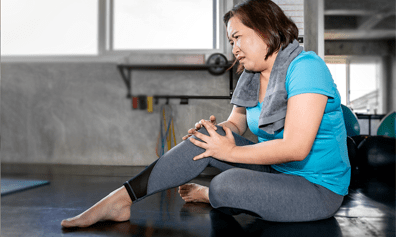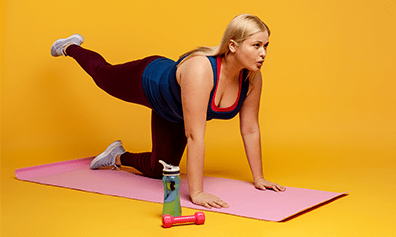
Exercise is a great way to relieve stress, build stamina, and improve strength and flexibility while also enjoying a lot more additional benefits. However, we also have to ensure we are doing it the right way to avoid the potential issues that might arise as a result of undue stress or strain on our joints or muscles. Running or jogging being the exercise of choice for many people, we have to be mindful of ensuring optimal health of our knees which suffer a large impact as a result of the running action potentially opening the doors to developing Runner’s knee.
What exactly is Runner’s knee?
Runner’s knee or patellofemoral pain syndrome (PFPS) is an overuse disorder that occurs when the knee is strained over and over again with the same movements.
Who is at risk for Runner’s knee?
Runner’s knee is usually seen in individuals who participate in a lot of physical activities that involve repetitive knee bending and straightening, activities like running, biking, or skiing. It can also occur in other people, especially women who do not participate in similar activities. Women tend to suffer from PFPS much more than men (1) with the teen and young adults showing the most incidence.
What are the signs and symptoms of Runner’s knee?
Patellofemoral pain syndrome causes pain towards the center of the knee, behind the knee cap or around the knee. The pain often gets worse with activities that involve knee bending like walking, kneeling, squatting, going up or down the stairs, or running. It may also hurt after sitting with a bent knee for a long time, such as in a long car ride or in a movie theater with the knee sometimes giving out. Some people with PFPS might feel a "popping" or creaking in their knee after getting up from sitting or when going up or down the stairs. Uneven surfaces, stairs, and elevated paths seem to aggravate the condition. Even simple daily tasks like getting up from the chair or climbing a flight of stairs can cause shooting pain in the joint.
Why does it occur?
Most common cause is usually poor conditioning of quadriceps (front thigh muscles), and tight hamstrings (muscles behind thigh) and calves, causing increased pressure on the knee with the patella (knee cap) going out of alignment. A mere repetitive force while running can give rise to Runner’s knee when the knee is compromised, to begin with.
Other causes can be biomechanical issues like malalignment, improper gait/running/jogging pattern. Anatomical problems like the patella riding too high in the femoral groove or easily dislocated patella, high-arched feet, or flat feet may also induce knee pain. In addition, reduced shock absorption in the knee due to worn cartilage can be another predisposing factor.
How do you manage it without affecting your lifestyle?
Some small changes to your fitness routine and handling your activities of daily living in a modified way would go a long way in handling Runner’s knee long term.
• At the first sign of pain, the intensity of the activity should be reduced to help speedy recovery of the knee.
• Strengthening the quadriceps while stretching the hamstrings and the calves should be the next step.
• Ensure you are wearing shoes with the right fit, sole and support during your activities.
• Avoid excessive knee bending exercises until the pain subsides.
• Swimming is a great alternative fitness route while the healing occurs as it improves strength and endurance without any extra load on the knee.
• If the pain still persists, meet your physician to rule out any other underlying causes.
When do you know you are safe and ready?
The following features would be an indication that you are good to go back to your original workout routine:
• Hip, leg, and core strength is near normal.
• Flexibility, especially in the hamstring muscle, has improved.
• There's no pain with everyday activities, such as walking and going up/down the stairs.
• Any pain with activity is very mild and goes away within a few minutes of starting the activity.
Summary
In summary, listen to your body and the warning it gives you in the form of pain or limitation during activity. It is probably hinting that you need to tackle the underlying issues to live a healthy life, working out the right way!
































































